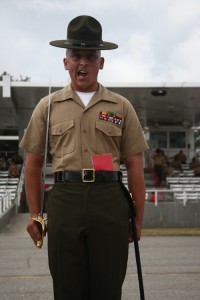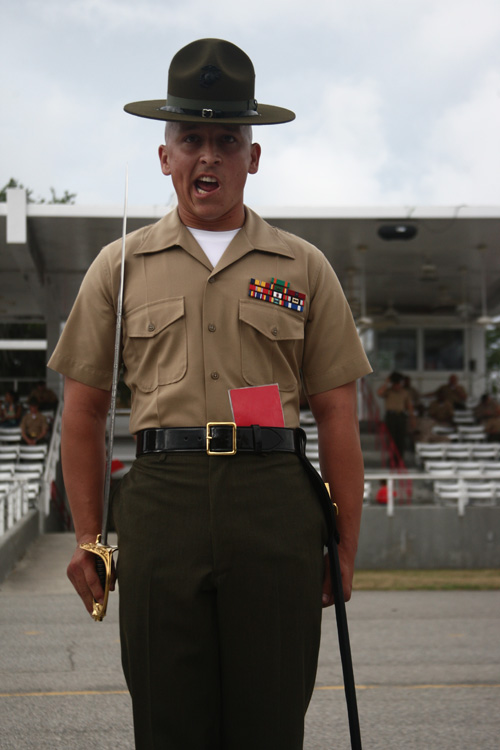
PARRIS ISLAND, S.C. – The crack of a recruits’ hand grasping their rifles, the sing-song cadence echoing or the unmistakable sounds of dozens of boots striking the ground in unison like a steady drum beat are sounds one would associate with close-order drill.
Recruits begin to learn about drill the moment they arrive on Parris Island, and they continue to use it throughout their Marine Corps careers. The first thing recruits do when they arrive is arrange themselves in a platoon formation on the famous yellow footprints. The may not know it, but they just began their drill training.
The discipline and attention to detail they develop in drill is shown in many aspects of training, from marching to breakfast to their final drill evaluation.
“Drill instills discipline, esprit de corps and camaraderie, all the things that we as Marines hold dear to our hearts and names,” said Gunnery Sgt. Nathaniel Keller, 35, drillmaster of 1st Recruit Training Battalion and native of Greenville, S.C.
In today’s military, drill serves several purposes: to move a unit from one place to another in an orderly manner, to teach discipline by instilling habits of precision and immediate response to orders, to increase confidence of junior leaders and to give troops an opportunity to handle weapons and to serve as a basis for combat formations.
But at Parris Island, drill is less about tactical application and more about a means to build teamwork and discipline.
Drill instructors learn how to teach their recruits in Drill Instructor School, where they dedicate at least 107 out of more than 500 hours of class time to learning the Marine Corps Drill and Ceremonies Manual and practicing, according to Gunnery Sgt. Levar Woods, the school’s drillmaster.
“We basically expand on what they already know,” said Woods, a 36-year-old Chicago native. “We make them perform as a leader in front of their peers to instill confidence, demeanor and a command presence so when the get in front of their subordinates, they don’t have any problems.”
Recruits learn more than 80 drill movements, both stationary and moving, during their time at Parris Island.
“When recruits first get here, they walk around all slumped over and scared, with no pride in their uniform,” said Staff Sgt. Mitchell Brown, drillmaster of 3rd Recruit Training Battalion. “But when their families get here, they comment on how different they are, because they stand tall and are confident in the uniform they wear. All of that is because of drill.”
Recruits compete in an initial drill evaluation at the end of their first phase of training and a final drill evaluation before they begin the Crucible, about a week before graduation; however, they are constantly being trained, corrected and perfected by their drill instructors.
“A platoon builds confidence during drill,” said Brown, a 24-year-old native of Atmore, Ala. “They learn there is no individual in drill. Individuals are what mess a platoon up, because they don’t look like the rest of the platoon. They all have to work together to do well.”
At least 34.5 hours is specifically scheduled for drill practice, but throughout training recruits spend many more hours than that preparing for their evaluations.
Recruits want to succeed in their evaluations, so they are willing to help other recruits who have difficulties with certain movements, which reinforces unit cohesion, said Brown.
Learning to work together as one unit goes hand-in-hand with the individual discipline.
“I have commanded squads in Afghanistan, and they know when I yell an order, they do it automatically,” said Brown. “That instant willing obedience to all orders comes back to the foundation that drill sets here in recruit training.”







